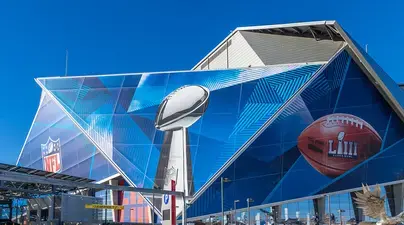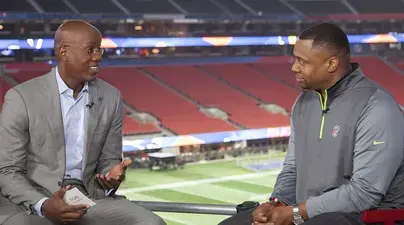Columbia University’s Master of Science in Sports Management is the only Ivy League program of its kind and features an elite network of faculty and industry experts in the areas of digital media, analytics, global sports, PR, finance, facilities and events, and intercollegiate athletics.
The Week Leading Up To the Big Game
As the most watched annual television broadcast in the United States, this year’s Super Bowl had television audiences captured long before kickoff. One of the most interesting storylines leading up to Super Bowl LIII was the location: Atlanta’s year-old Mercedes-Benz Stadium. This state-of-the-art stadium, with its renowned halo scoreboard and retractable roof, has also become the center of a concession industry revolution.

Mercedes-Benz Stadium in Atlanta, home of Super Bowl LIII — and a successful experiment in reduced concession prices.
Two seasons ago, Atlanta Falcons owner Arthur Blank unveiled a grand experiment in professional sports by decreasing concession prices by upwards of 50%, even offering $5 beers and $2 hot dogs. What seemed to be revolutionary in theory has proven to be a well-taken risk by Blank’s front office staff. In the program’s first year, fans have spent 16% more on concessions overall in the new building, according to media reports.
“He has absolutely been successful in that gutsy, smart move,” Scott Rosner, Academic Director of Columbia’s Sports Management program, told CBS Saturday Morning. “The lifetime value of the customer, for the Atlanta sports fan is, I think, quite higher now because people want to go there. They don’t feel like they’re being taken advantage of. It’s an affordable experience.”
The Business of the Big Game
The Super Bowl has long been the most watched television event in the United States, and it is estimated that 25% of viewers watch solely for the commercials. Super Bowl commercials are a business of their own, with commercial prices remaining stagnant in 2019 due in part to brands sticking to the same model of advertising.
“It’s a huge missed opportunity to pass on mobilizing a Super Bowl audience with a product experience,” says Michael Neuman, founder of Scout Sports and Entertainment and lecturer for the Sports Management master’s program. “The Super Bowl is the time to experiment and take risks as the audience is highly engaged for the commercials.”
In addition to commercial prices, NFL ratings have also experienced a bit of a roller coaster ride over the past three years. In 2016 and 2017, national television ratings plummeted nearly 10% annually. In addition, the League was besieged by controversy over concussions and player safety, players’ domestic abuse cases, and an ongoing national anthem debate, which may have played a part in diminished ratings. However, the same ratings increased 5% this year due in large part to increased offensive output, stronger performance by large market teams, and the emergence of compelling young players. Yet this year’s Super Bowl had the smallest overnight television rating in nine years, likely due to a low-scoring game.
Neal Pilson, former President of CBS Sports and a Sports Management faculty member, accurately predicted NFL ratings would rebound after this disappointing drop.
“The NFL had dramatically improved the schedule for Thursday and Monday nights,” Pilson says. “Plus, I thought the issues about the players were not going to be as big this year, and that turned out to be the case.”
Life After the Big Game
As many athletes rise to new heights financially on the field, players are beginning to look beyond their playing days and build a plan for long-term success. The week leading up to the Super Bowl, Dr. Jason Wingard, Dean of Columbia’s School of Professional Studies, asked Troy Vincent, Executive Vice President of Football Operations for the NFL, about his transition from an NFL player to a leader of the league.

Dr. Jason Wingard, Dean of Columbia University’s School of Professional Studies, interviews Troy Vincent, EVP of Football Operations for the NFL.
“I'm still transitioning, and I try to share with my colleagues that transition takes a lifetime,” Vincent says. “As leaders, a necessary quality is listening. I've always prided myself on being a great listener. I don't have all of the answers. I also value being intentional about what I want to be, how I want to be represented, and who I'm representing.”
Another example of players looking to transition to life off the field was on display during the Patriots’ victory parade. Tom Brady and Julian Edelman didn’t wear Patriots championship merchandise but their own branded T-shirts, which are readily available for sale. These two Super Bowl MVPs are a microcosm of a growing trend of athletes creating individual brands.
According to Joe Favorito, another lecturer for Columbia’s Sports Management program who also who co-hosts the Columbia University Sports Podcast, it takes a perfect combination of creativity, marketing, and platform to successfully develop such a personal brand.
“Many times the cost of inventory, or the cost of controllable images, especially ones where marks are held by teams or leagues, have limited creativity and profitability,” says Favorito. “However now, for the forward-thinking, but also a well-positioned athlete as a brand, complete control on sale, distribution, and most importantly, creative license can be in his or her hands.”
Learn more about the M.S. in Sports Management program at Columbia University’s School of Professional Studies.